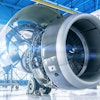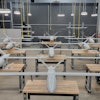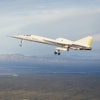The airplane was still barely a teenager when the United States entered World War I, and the U.S. Army’s fledgling aeronautical division wanted to make its airplanes fly higher without losing power.
Sanford Moss, a GE engineer and one of the brightest minds in the steam turbine business, had an idea. He and his team designed a device called turbosupercharger. It used exhaust fumes coming from an aircraft engine to power a small turbine. The turbine increased the air pressure in the engine’s cylinders and gave it more oomph, especially at high altitudes where the air is thinner.
In 1918, Moss took the device to Pikes Peak in Colorado, elev. 14,000 ft., and proved that a supercharged Liberty V-12 aircraft engine performed much better at this height than the standard version. The government was pleased and GE started making superchargers for the Army.
It was this contract that launched GE into air. Today, there are more than 30,000 GE aircraft engines in service, from tuboprops powering commuter planes to the world’s highest elevation airports in the Himalayas, to the largest and most powerful jet engine ever built. Take a look at the highlights.
First aircraft turbosupercharger: In 1921, a LePere biplane equipped with Moss’ turbosupercharger set a world altitude record, reaching 40,800 ft. In 1937, Howard Hughes used the device on his record-breaking transcontinental flight from Newark, N.J., to Los Angeles lasting 7 hours, 28 minutes and 25 seconds. GE Aviation made turbosuperchargers for several decades. Later versions of the technology served on B-17, B-24 and B-29 bombers during World War II. Since GE was not yet making engines, they worked with Pratt & Whitney and Curtiss-Wright piston engines.
The heated, high-altitude flying suit: These WWII bombers flew missions above 25,000 feet without pressurized or heated cabins. At that height, crews had to wear oxygen masks to remain conscious and protect themselves from temperatures so low that exposed skin froze to metal. GE engineers stepped in to help. They designed a heated flying suit for high altitudes by drawing on previous experience from a successful but decisively non-military product: electric blankets.
First U.S. Jet Engine: In the fall of 1941, a top secret group of GE engineers nicknamed the Hush-Hush Boys used Sir Frank Whittle’s British jet engine design to build America’s first jet engine. The prototype flew in 1942, and the jet engine entered service in 1944, powering the Lockheed P-80 Shooting Star, the first jet fighter in the U.S. Air Force’s arsenal.
First U.S. Commercial Jet Engine: In 1947, GE’s J47 engine became the first jet engine certified for commercial aviation in the U.S. GE made more than 35,000 of them. They found a handful of applications outside aviation. The Spirit of America jet car used one, and a pair of them powered what is still the world’s fastest jet-propelled train. They also served on the railroad as heavy-duty snowblowers.
Early supersonic engines: In 1948, GE hired German aviation pioneer Gerhard Neumann, who quickly went to work on the jet engine. He developed a revolutionary design called variable stator (above). It allowed pilots to turn the vanes on the engine’s stator, change the pressure inside the turbine, and make planes routinely fly faster than the speed of sound.
When GE started testing the first jet engine with Neumann’s variable stator, engineers thought that their instruments were malfunctioning because of the amount of power it produced. In the 1960s, the GE-powered XB-70 Valkyrie aircraft was flying in excess of Mach 3, three times the speed of sound.
The nuclear-powered jet engine: In 1954, GE even put a nuclear-powered jet engine on a test stand in Arco, Idaho. It ran for more than 100 trouble-free hours before the project was shelved. The idea was that the the engine would use heat produced by a nuclear reactor aboard the plane to generate thrust. A plane with these engines could theoretically stay in the air for days and weeks. Although the U.S. Air Force did modify a B-36 Peacemaker bomber to carry a nuclear reactor, it never used the engines.
The first high-bypass turbofan engine: In the 1960s, GE engineers started working on a new powerful jet engine that could lift heavy loads across long distances, but also made planes more fuel efficient. They came up with the TF39 engine, which generated a record 40,000 pounds of thrust. Although it was developed for the military, later versions of the engine launched the CF-6 family of engines, which has powered DC-10s, Lockheed L1011s, and Boeing 747 passenger jets, including Air Force One.
The first unducted turbofan: Following the oil crisis in the 1970s, GE and NASA developed a funny looking engine design called “unducted turbofan”. The engine, named GE36, was a cross between a jet and a propeller engine. For the first time, the fuel efficient machine used fan blades made from light and tough carbon fiber composites. GE is still the only company in the jet engine business using these materials on engine fans. In 1988, a GE36-powered MD-80 passenger jet flew from the U.S. to the Farnborough Air Show in England.
The world’s largest and most powerful engine: Although the unducted turbofan didn’t catch on, the carbon fiber blade technology allowed GE engineers to build a new a line of massive high-bypass turbofan engines, including the GE90-115B. It is the world’s most powerful jet engine, capable of generating 115,000 pounds of thrust. Its next version called the GE9X will be the world’s largest engine with a fan that’s 11 feet in diameter (that engine is still in development).
First engines with 3-D printed parts and new ceramic materials: The LEAP jet engine is the first jet engine with 3-D printer fuel nozzles and components made from strong ceramic matrix composites (CMCs), which are much lighter than even high-grade alloys. The LEAP, which is 15 percent more fuel efficient than comparable GE engines, was developed by CFM International, a joint venture between GE Aviation and France’s Snecma (Safran). CFM has received more than $100 billion in orders and commitments (U.S. list price) for over 7,700 LEAPs. It will enter service until 2016.
First spinning parts from ceramics: GE spent two decades developing CMCs. Scientists at GE Global Research tried to shoot a steel ball flying at 150 mph through a sample, but failed. The scored a breakthrough when it for the first time successfully tested rotating parts made from CMCs inside a jet engine turbine. “Going from nickel alloys to rotating ceramics inside the engine is the really big jump,” says Jonathan Blank, who leads CMC and advanced polymer matrix composite research at GE Aviation. “CMCs allow for a revolutionary change in jet engine design.”
The superjet: Engineers at GE Aviation developed a new “adaptive cycle” engine for sixth-generation fighter jets. It’s called ADVENT and it can switch between high power and high efficiency modes. “We are making a generational leap with this technology,” says Dan McCormick, manager for adaptive cycle engine programs at GE Aviation. “We are looking at speed and performance, but also fuel savings of 25 percent. That extra fuel could increase how far a military jet flies by up to 35 percent. That’s huge.”
Flying to the top of the world: Lukla’s Tenzing-Hillary airport in Nepal is probably the most extreme commercial airport in the world. Perched 9,382 feet high, in a valley filled with wicked wind shear, it has a fearsome uphill runway just four football fields long that ends in a rock wall. Some of the planes that fly there are powered by propeller engines made by GE.
For more stories like this, visit GE Reports.























